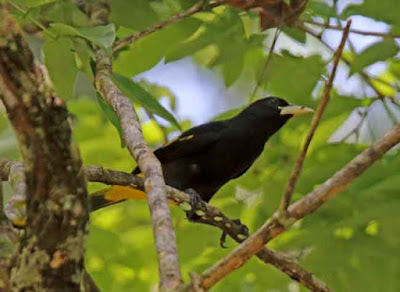I finally made it back to Colombia for my second visit and again used the guide services of Pablo Florez. I went with my friend Martin Jackson. We visited Inirida on the Orinoco, Santa Marta of course, Guajira Peninsula on the Caribbean coast, and a couple of National Parks around Bogota.
The 6" Santa Marta Antbird (Drymophilia hellmayri) is endemic to those mountains. It has brown wings and a black and white streaked throat. The sexes are very similar. It was formerly one of 4 species called Long-tailed Antbird.
 |
| Santa Marta Antbird |
The 4.5" female Black-chinned Antbird (Hypocnemoides melanopogon) is a gray bird with a white throat and faint black streaks. The male has a black throat. Their habitat of flooded forest foraging just above the water line is diagnostic. We had a pair about 10 meters away in deep shadow just before dusk. It was too dark to get a photo, but just as we were about to leave in the boat, the female flew and landed in the open right beside the boat!
 |
| Black-chinned Antbird - female |
The beautiful male 6" White-bellied Antbird (Myrmeciza longipes) is 'unlike any other' and an easy ID. This bird is the easiest antbird I have ever photographed. He came to within 2 meters, in the open, and sang continuously.
 |
| White-bellied Antbird |
 |
| Dot-backed Antbird |
The 5" male Southern White-fringed Antwren (Formicivora grisea) is an easy ID. he is brown above and black below with a white line between them. It was recently split into Northern and Southern species
 |
| Southern White-fringed Antwren - male |
Antpittas are a closely related family to antbirds - and usually even more difficult to see and photograph. But in the past 20 years, it was discovered that they can be trained to come to a feeder enticed by worms. I photographed 3 species on the trip and saw a 4th one.
I have photos of 29 of the 238 species of antbirds
David McDonald
dkmmdpa@gmail.com
photos copyright 2006 - 2021 David McDonald
To have these trip reports sent to your email, please email me at the above address and ask to subscribe.




















































